Unique Regulation of Na-K-ATPase during Growth and Maturation of Intestinal Epithelial Cells
Abstract
1. Introduction
2. Results
2.1. Alkaline Phosphatase (ALP) Levels during Cell Maturation
2.2. Na-Dependent Glucose Uptake during Cell Maturation
2.3. Na-K-ATPase Activity Levels during Cell Maturation
2.4. Kinetic Studies of Na-K-ATPase Activity during Cell Maturation
2.5. Na-K-ATPase α1 and Na-K-ATPase β1 Subunit mRNA Abundance during Cell Maturation
2.6. Na-K-ATPase α1 and Na-K-ATPase β1 Subunit Protein Expression during Cell Maturation
2.7. Protein Phosphorylation Levels of Na-K-ATPase α1 Subunit during Cell Maturation
3. Discussion
4. Materials and Methods
4.1. Cell Culture
4.2. Alkaline Phosphatase Activity (ALP) Assay
4.3. Na-Dependent Glucose Uptake Studies
4.4. Crude Plasma Membrane Isolation
4.5. Na-K-ATPase Activity Assay
4.6. Determination of Na-K-ATPase Activity and Kinetics by 86Rb+ Uptake
4.7. RNA Isolation and Quantitative Real-Time Polymerase Chain Reaction (qRT-PCR)
4.8. Immunoprecipitation
4.9. Western Blot Analysis
4.10. Protein Determination
4.11. Statistical Analysis
5. Conclusions
Author Contributions
Funding
Acknowledgments
Conflicts of Interest
References
- Gerbe, F.; Legraverend, C.; Jay, P. The intestinal epithelium tuft cells: Specification and function. Cell. Mol. Life Sci. 2012, 69, 2907–2917. [Google Scholar] [CrossRef] [PubMed]
- De Santa Barbara, P.; van den Brink, G.R.; Roberts, D.J. Development and differentiation of the intestinal epithelium. Cell. Mol. Life Sci. 2003, 60, 1322–1332. [Google Scholar] [CrossRef]
- Babyatsky, M.W.; Podolsky, D.K. Growth and development of the gastrointestinal tract. In Textbook of Gastroenterology; Yamada, T., Ed.; Lippincott: Philadelphia, PA, USA, 1999; pp. 547–584. [Google Scholar]
- Kay, A.R. How Cells Can Control Their Size by Pumping Ions. Front. Cell Dev. Biol. 2017, 5, 41. [Google Scholar] [CrossRef] [PubMed]
- Kaplan, J.H. Biochemistry of Na,K-ATPase. Annu. Rev. Biochem. 2002, 71, 511–535. [Google Scholar] [CrossRef]
- Skou, J.C. The fourth Datta lecture. The energy coupled exchange of Na+ for K+ across the cell membrane. The Na+,K+-pump. FEBS Lett. 1990, 268, 314–324. [Google Scholar] [CrossRef]
- Skou, J.C.; Esmann, M. The Na,K-ATPase. J. Bioenerg. Biomembr. 1992, 24, 249–261. [Google Scholar] [PubMed]
- Ejderhamn, J.; Finkel, Y.; Strandvik, B. Na,K-ATPase activity in rectal mucosa of children with ulcerative colitis and Crohn’s disease. Scand. J. Gastroenterol. 1989, 24, 1121–1125. [Google Scholar] [CrossRef] [PubMed]
- Rachmilewitz, D.; Karmeli, F.; Sharon, P. Decreased colonic Na-K-ATPase activity in active ulcerative colitis. Isr. J. Med. Sci. 1984, 20, 681–684. [Google Scholar] [PubMed]
- Sundaram, U.; West, A.B. Effect of chronic inflammation on electrolyte transport in rabbit ileal villus and crypt cells. Am. J. Physiol. 1997, 272 Pt 1, G732–G741. [Google Scholar] [CrossRef]
- Shull, G.E.; Lane, L.K.; Lingrel, J.B. Amino-acid sequence of the beta-subunit of the (Na+ + K+)ATPase deduced from a cDNA. Nature 1986, 321, 429–431. [Google Scholar] [CrossRef] [PubMed]
- Shull, G.E.; Schwartz, A.; Lingrel, J.B. Amino-acid sequence of the catalytic subunit of the (Na+ + K+)ATPase deduced from a complementary DNA. Nature 1985, 316, 691–695. [Google Scholar] [CrossRef] [PubMed]
- Béguin, P.; Wang, X.; Firsov, D.; Puoti, A.; Claeys, D.; Horisberger, J.D.; Geering, K. The gamma subunit is a specific component of the Na,K-ATPase and modulates its transport function. EMBO J. 1997, 16, 4250–4260. [Google Scholar] [PubMed]
- Arystarkhova, E.; Wetzel, R.K.; Asinovski, N.K.; Sweadner, K.J. The gamma subunit modulates Na+ and K+ affinity of the renal Na,K-ATPase. J. Biol. Chem. 1999, 274, 33183–33185. [Google Scholar] [CrossRef] [PubMed]
- Geering, K. The functional role of beta subunits in oligomeric P-type ATPases. J. Bioenerg. Biomembr. 2001, 33, 425–438. [Google Scholar] [CrossRef] [PubMed]
- Ackermann, U.; Geering, K. Mutual dependence of Na,K-ATPase alpha- and beta-subunits for correct posttranslational processing and intracellular transport. FEBS Lett. 1990, 269, 105–108. [Google Scholar] [CrossRef]
- McDonough, A.A.; Geering, K.; Farley, R.A. The sodium pump needs its beta subunit. FASEB J. 1990, 4, 1598–1605. [Google Scholar] [CrossRef] [PubMed]
- Blanco, G.; Melton, R.J.; Sanchez, G.; Mercer, R.W. Functional characterization of a testes-specific alpha-subunit isoform of the sodium/potassium adenosinetriphosphatase. Biochemistry 1999, 38, 13661–13669. [Google Scholar] [CrossRef]
- Mercer, R.W. Structure of the Na,K-ATPase. Int. Rev. Cytol. 1993, 137C, 139–168. [Google Scholar]
- Blanco, G.; Mercer, R.W. Isozymes of the Na-K-ATPase: Heterogeneity in structure, diversity in function. Am. J. Physiol. 1998, 275, F633–F650. [Google Scholar] [CrossRef]
- Jewell, E.A.; Shamraj, O.I.; Lingrel, J.B. Isoforms of the alpha subunit of Na,K-ATPase and their significance. Acta Physiol. Scand. Suppl. 1992, 607, 161–169. [Google Scholar]
- Saha, P.; Manoharan, P.; Arthur, S.; Sundaram, S.; Kekuda, R.; Sundaram, U. Molecular mechanism of regulation of villus cell Na-K-ATPase in the chronically inflamed mammalian small intestine. Biochim. Biophys. Acta 2015, 1848, 702–711. [Google Scholar] [CrossRef] [PubMed]
- Blanco, G.; Sanchez, G.; Mercer, R.W. Differential regulation of Na,K-ATPase isozymes by protein kinases and arachidonic acid. Arch. Biochem. Biophys. 1998, 359, 139–150. [Google Scholar] [CrossRef] [PubMed]
- McDonough, A.A.; Farley, R.A. Regulation of Na,K-ATPase activity. Curr. Opin. Nephrol. Hypertens. 1993, 2, 725–734. [Google Scholar] [CrossRef] [PubMed]
- Bertorello, A.M.; Katz, A.I. Short-term regulation of renal Na-K-ATPase activity: Physiological relevance and cellular mechanisms. Am. J. Physiol. 1993, 265 Pt 2, F743–F755. [Google Scholar] [CrossRef]
- Ewart, H.S.; Klip, A. Hormonal regulation of the Na(+)-K(+)-ATPase: Mechanisms underlying rapid and sustained changes in pump activity. Am. J. Physiol. 1995, 269 Pt 1, C295–C311. [Google Scholar] [CrossRef]
- Singh, S.; Arthur, S.; Talukder, J.; Palaniappan, B.; Coon, S.; Sundaram, U. Mast cell regulation of Na-glutamine co-transporters B0AT1 in villus and SN2 in crypt cells during chronic intestinal inflammation. BMC Gastroenterol. 2015, 15, 47. [Google Scholar] [CrossRef] [PubMed]
- Hwang, E.S.; Hirayama, B.A.; Wright, E.M. Distribution of the SGLT1 Na+/glucose cotransporter and mRNA along the crypt-villus axis of rabbit small intestine. Biochem. Biophys. Res. Commun. 1991, 181, 1208–1217. [Google Scholar] [CrossRef]
- Coon, S.; Kim, J.; Shao, G.; Sundaram, U. Na-glucose and Na-neutral amino acid cotransport are uniquely regulated by constitutive nitric oxide in rabbit small intestinal villus cells. Am. J. Physiol. Gastrointest. Liver Physiol. 2005, 289, G1030–G1035. [Google Scholar] [CrossRef]
- Yang, H.; Wang, X.; Xiong, X.; Yin, Y. Energy metabolism in intestinal epithelial cells during maturation along the crypt-villus axis. Sci. Rep. 2016, 6, 31917. [Google Scholar] [CrossRef]
- Fan, M.Z.; Stoll, B.; Jiang, R.; Burrin, D.G. Enterocyte digestive enzyme activity along the crypt-villus and longitudinal axes in the neonatal pig small intestine. J. Anim. Sci. 2001, 79, 371–381. [Google Scholar] [CrossRef]
- Blostein, R.; Drapeau, P.; Benderoff, S.; Weigensberg, A.M. Changes in Na+-ATPase and Na,K-pump during maturation of sheep reticulocytes. Can. J. Biochem. Cell Biol. 1983, 61, 23–28. [Google Scholar] [CrossRef] [PubMed]
- Brugnara, C.; de Franceschi, L. Effect of cell age and phenylhydrazine on the cation transport properties of rabbit erythrocytes. J. Cell. Physiol. 1993, 154, 271–280. [Google Scholar] [CrossRef] [PubMed]
- Furukawa, H.; Bilezikian, J.P.; Loeb, J.N. Potassium fluxes in the rat reticulocyte Ouabain sensitivity and changes during maturation. Biochim. Biophys. Acta 1981, 649, 625–632. [Google Scholar] [CrossRef]
- Mairbaurl, H.; Schulz, S.; Hoffman, J.F. Cation transport and cell volume changes in maturing rat reticulocytes. Am. J. Physiol. Cell Physiol. 2000, 279, C1621–C1630. [Google Scholar] [CrossRef] [PubMed]
- Vasarhelyi, B.; Tulassay, T.; Ver, A.; Dobos, M.; Kocsis, I.; Seri, I. Developmental changes in erythrocyte Na+,K+-ATPase subunit abundance and enzyme activity in neonates. Arch. Dis. Child. Fetal Neonatal Ed. 2000, 83, F135–F138. [Google Scholar] [CrossRef] [PubMed]
- Wang, Z.M.; Celsi, G. Glucocorticoids differentially regulate the mRNA for Na+,K+-ATPase isoforms in infant rat heart. Pediatr. Res. 1993, 33, 1–4. [Google Scholar] [CrossRef][Green Version]
- Wang, Z.M.; Yasui, M.; Celsi, G. Glucocorticoids regulate the transcription of Na+-K+-ATPase genes in the infant rat kidney. Am. J. Physiol. 1994, 267 Pt 1, C450–C455. [Google Scholar] [CrossRef]
- Erichsen, S.; Zuo, J.; Curtis, L.; Rarey, K.; Hultcrantz, M. Na,K-ATPase alpha- and beta-isoforms in the developing cochlea of the mouse. Hear. Res. 1996, 100, 143–149. [Google Scholar] [CrossRef]
- Pedemont, C.H.; Bertorello, A.M. Short-term regulation of the proximal tubule Na+,K+-ATPase: Increased/decreased Na+,K+-ATPase activity mediated by protein kinase C isoforms. J. Bioenerg. Biomembr. 2001, 33, 439–447. [Google Scholar] [CrossRef]
- Rajasekaran, S.A.; Barwe, S.P.; Rajasekaran, A.K. Multiple functions of Na,K-ATPase in epithelial cells. Semin. Nephrol. 2005, 25, 328–334. [Google Scholar] [CrossRef]
- Rosen, K.G.; Sigstrom, L. The influence of age on Na-K-ATP-ase activity in erythrocytes in fetal and newborn guinea pigs. J. Perinat. Med. 1978, 6, 154–159. [Google Scholar] [CrossRef] [PubMed][Green Version]
- Curtis, L.M.; ten Cate, W.J.; Rarey, K.E. Dynamics of Na,K-ATPase sites in lateral cochlear wall tissues of the rat. Eur. Arch. Otorhinolaryngol. 1993, 250, 265–270. [Google Scholar] [CrossRef] [PubMed]
- Tokhtaeva, E.; Clifford, R.J.; Kaplan, J.H.; Sachs, G.; Vagin, O. Subunit isoform selectivity in assembly of Na,K-ATPase alpha-beta heterodimers. J. Biol. Chem. 2012, 287, 26115–26125. [Google Scholar] [CrossRef] [PubMed]
- Faleiros, R.O.; Garcon, D.P.; Lucena, M.N.; McNamara, J.C.; Leone, F.A. Short- and long-term salinity challenge, osmoregulatory ability, and (Na+,K+)-ATPase kinetics and alpha-subunit mRNA expression in the gills of the thinstripe hermit crab Clibanarius symmetricus (Anomura, Diogenidae). Comp. Biochem. Physiol. A Mol. Integr. Physiol. 2018, 225, 16–25. [Google Scholar] [CrossRef] [PubMed]
- Kristensen, M.; Juel, C. Na+,K+-ATPase Na+ affinity in rat skeletal muscle fiber types. J. Membr. Biol. 2010, 234, 35–45. [Google Scholar] [CrossRef] [PubMed]
- Beguin, P.; Beggah, A.T.; Chibalin, A.V.; Burgener-Kairuz, P.; Jaisser, F.; Mathews, P.M.; Rossier, B.C.; Cotecchia, S.; Geering, K. Phosphorylation of the Na,K-ATPase alpha-subunit by protein kinase A and C in vitro and in intact cells. Identification of a novel motif for PKC-mediated phosphorylation. J. Biol. Chem. 1994, 269, 24437–24445. [Google Scholar] [PubMed]
- Bertorello, A.M.; Aperia, A.; Walaas, S.I.; Nairn, A.C.; Greengard, P. Phosphorylation of the catalytic subunit of Na+,K(+)-ATPase inhibits the activity of the enzyme. Proc. Natl. Acad. Sci. USA 1991, 88, 11359–11362. [Google Scholar] [CrossRef] [PubMed]
- Chibalin, A.V.; Vasilets, L.A.; Hennekes, H.; Pralong, D.; Geering, K. Phosphorylation of Na,K-ATPase alpha-subunits in microsomes and in homogenates of Xenopus oocytes resulting from the stimulation of protein kinase A and protein kinase C. J. Biol. Chem. 1992, 267, 22378–22384. [Google Scholar]
- Fisone, G.; Cheng, S.X.; Nairn, A.C.; Czernik, A.J.; Hemmings, H.C., Jr.; Höög, J.O.; Bertorello, A.M.; Kaiser, R.; Bergman, T.; Jörnvall, H. Identification of the phosphorylation site for cAMP-dependent protein kinase on Na+,K(+)-ATPase and effects of site-directed mutagenesis. J. Biol. Chem. 1994, 269, 9368–9373. [Google Scholar]
- Feraille, E.; Carranza, M.L.; Gonin, S.; Beguin, P.; Pedemonte, C.; Rousselot, M.; Caverzasio, J.; Geering, K.; Martin, P.-Y.; Favre, H. Insulin-induced stimulation of Na+,K+-ATPase activity in kidney proximal tubule cells depends on phosphorylation of the alpha-subunit at Tyr-10. Mol. Biol. Cell 1999, 10, 2847–2859. [Google Scholar] [CrossRef]
- El-Beialy, W.; Galal, N.; Deyama, Y.; Yoshimura, Y.; Suzuki, K.; Tei, K.; Totsuka, Y. Regulation of human and pig renal Na+,K+-ATPase activity by tyrosine phosphorylation of their alpha(1)-subunits. J. Membr. Biol. 2010, 233, 119–126. [Google Scholar] [CrossRef] [PubMed]
- Soltoff, S.P.; Asara, J.M.; Hedden, L. Regulation and identification of Na,K-ATPase alpha1 subunit phosphorylation in rat parotid acinar cells. J. Biol. Chem. 2010, 285, 36330–36338. [Google Scholar] [CrossRef] [PubMed]
- Al-Khalili, L.; Kotova, O.; Tsuchida, H.; Ehren, I.; Feraille, E.; Krook, A.; Chibalin, A.V. ERK1/2 mediates insulin stimulation of Na(+),K(+)-ATPase by phosphorylation of the alpha-subunit in human skeletal muscle cells. J. Biol. Chem. 2004, 279, 25211–25218. [Google Scholar] [CrossRef] [PubMed]
- Havrankova, J.; Roth, J.; Brownstein, M. Insulin receptors are widely distributed in the central nervous system of the rat. Nature 1978, 272, 827–829. [Google Scholar] [CrossRef] [PubMed]
- Forbush, B., 3rd. Assay of Na,K-ATPase in plasma membrane preparations: Increasing the permeability of membrane vesicles using sodium dodecyl sulfate buffered with bovine serum albumin. Anal. Biochem. 1983, 128, 159–163. [Google Scholar] [CrossRef]
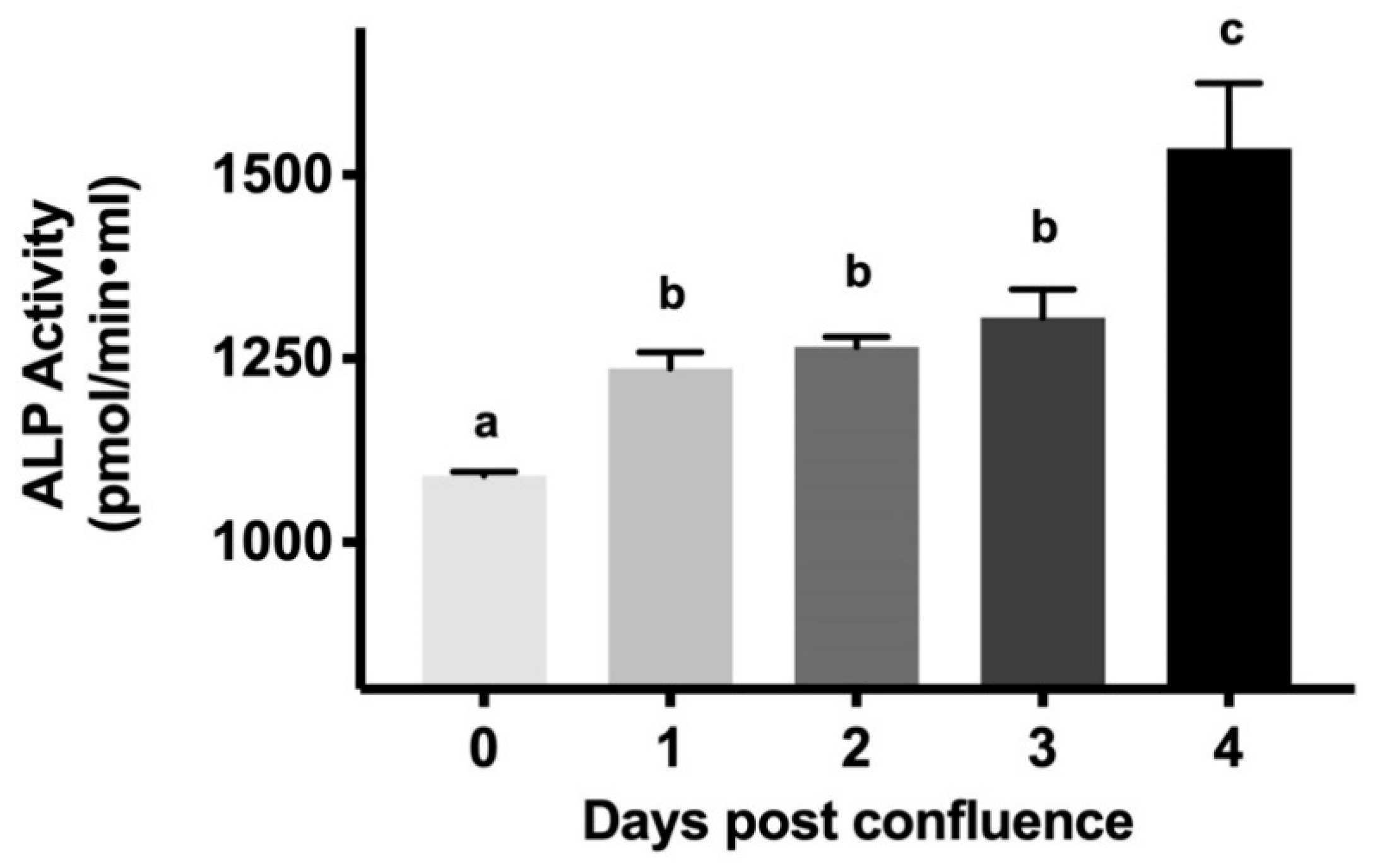
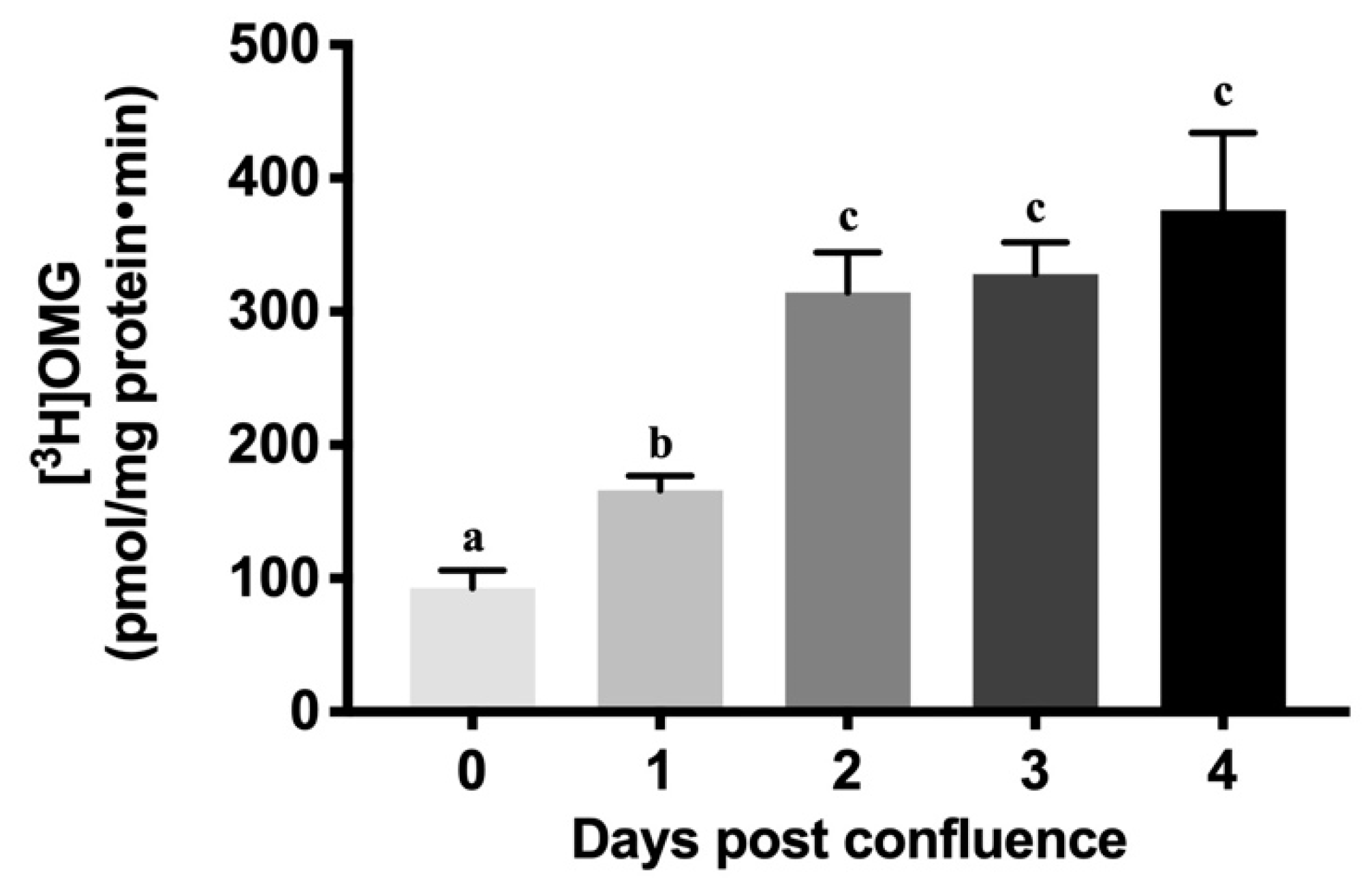
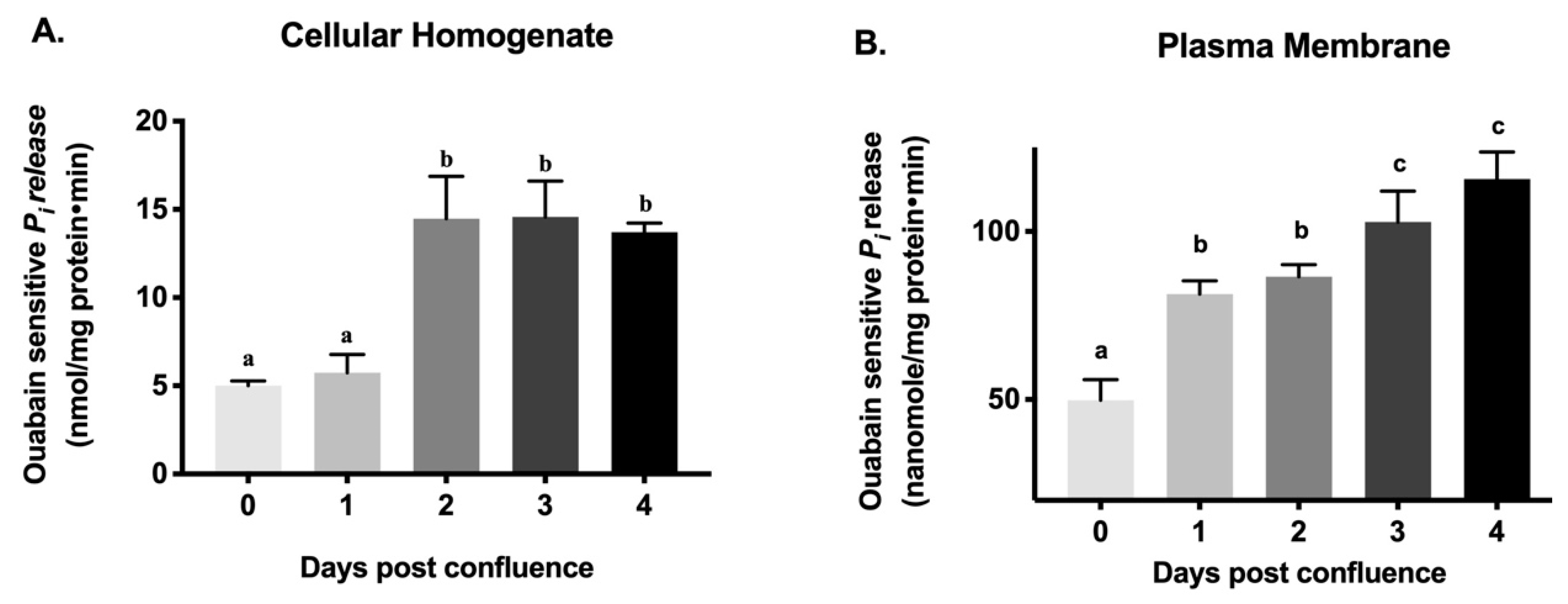
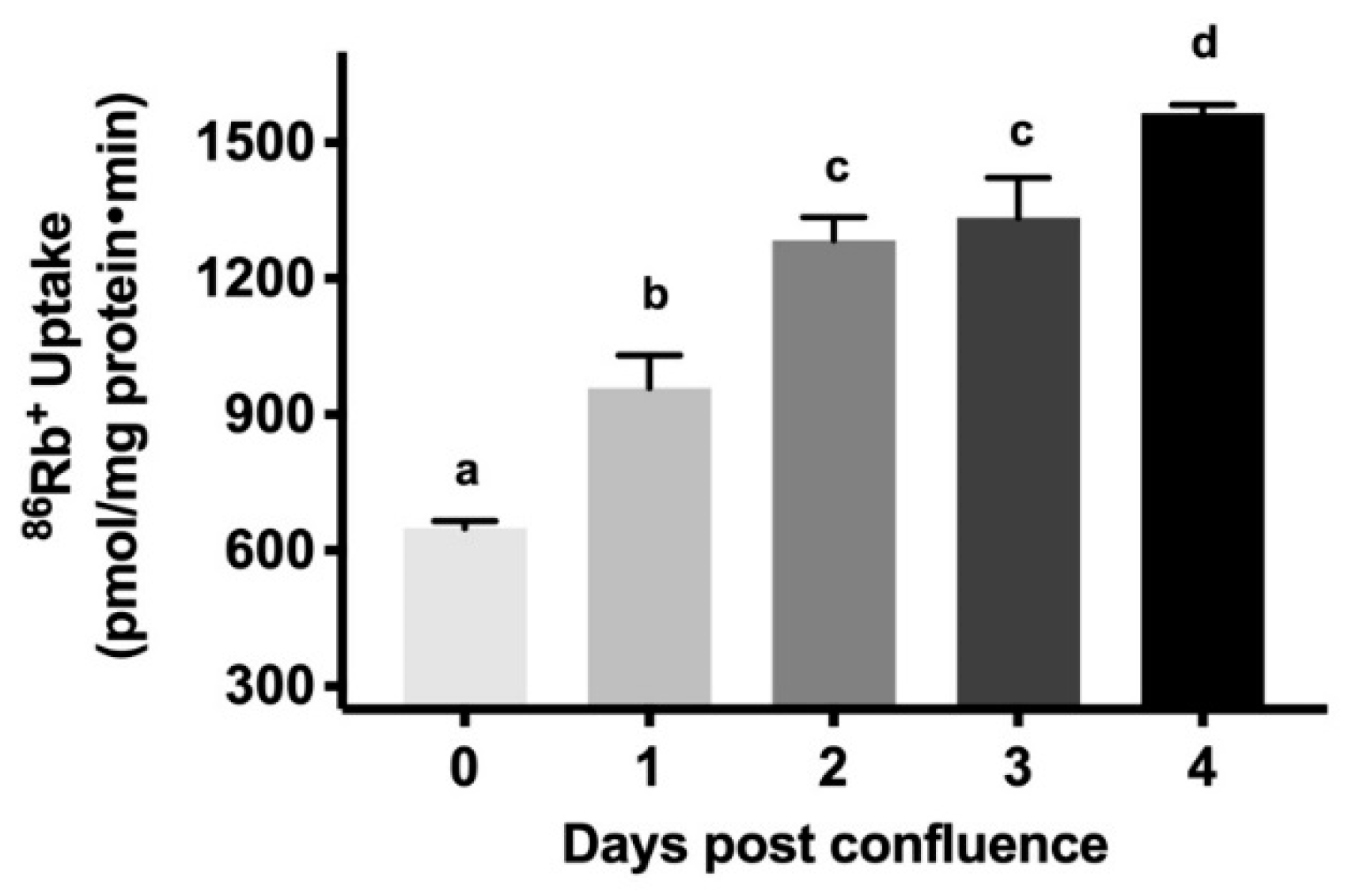
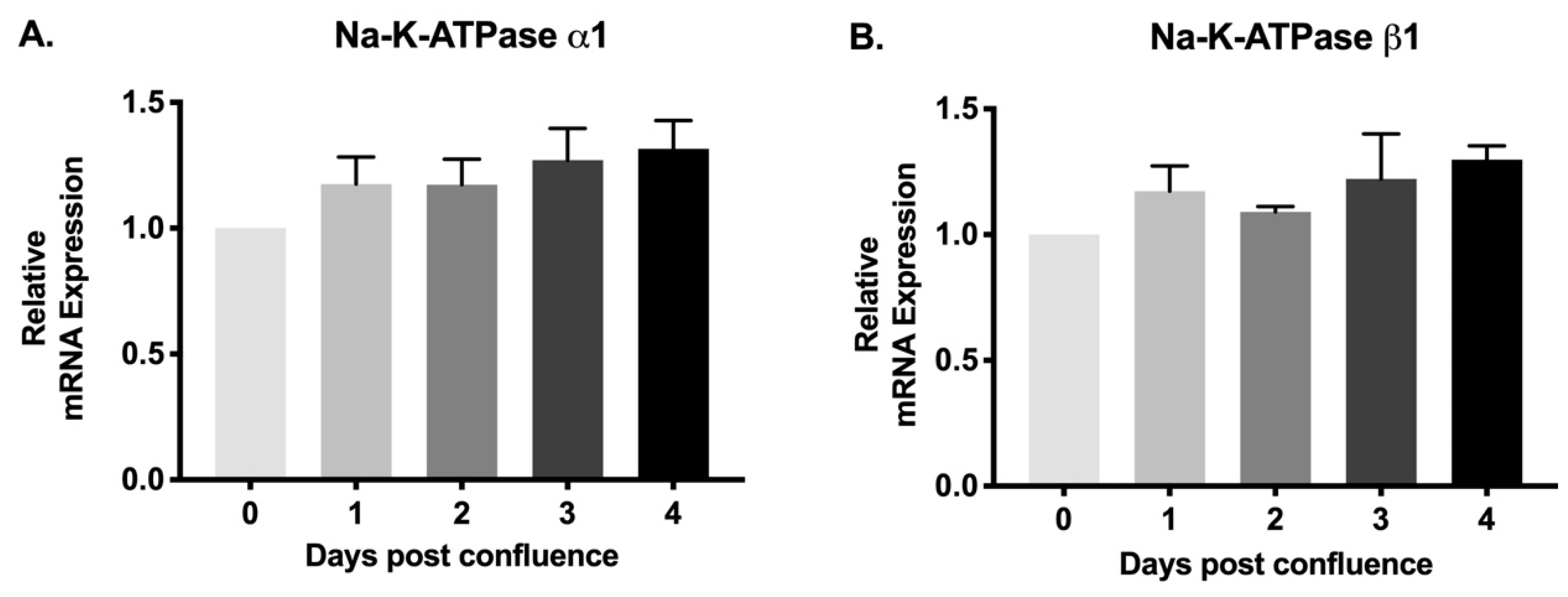
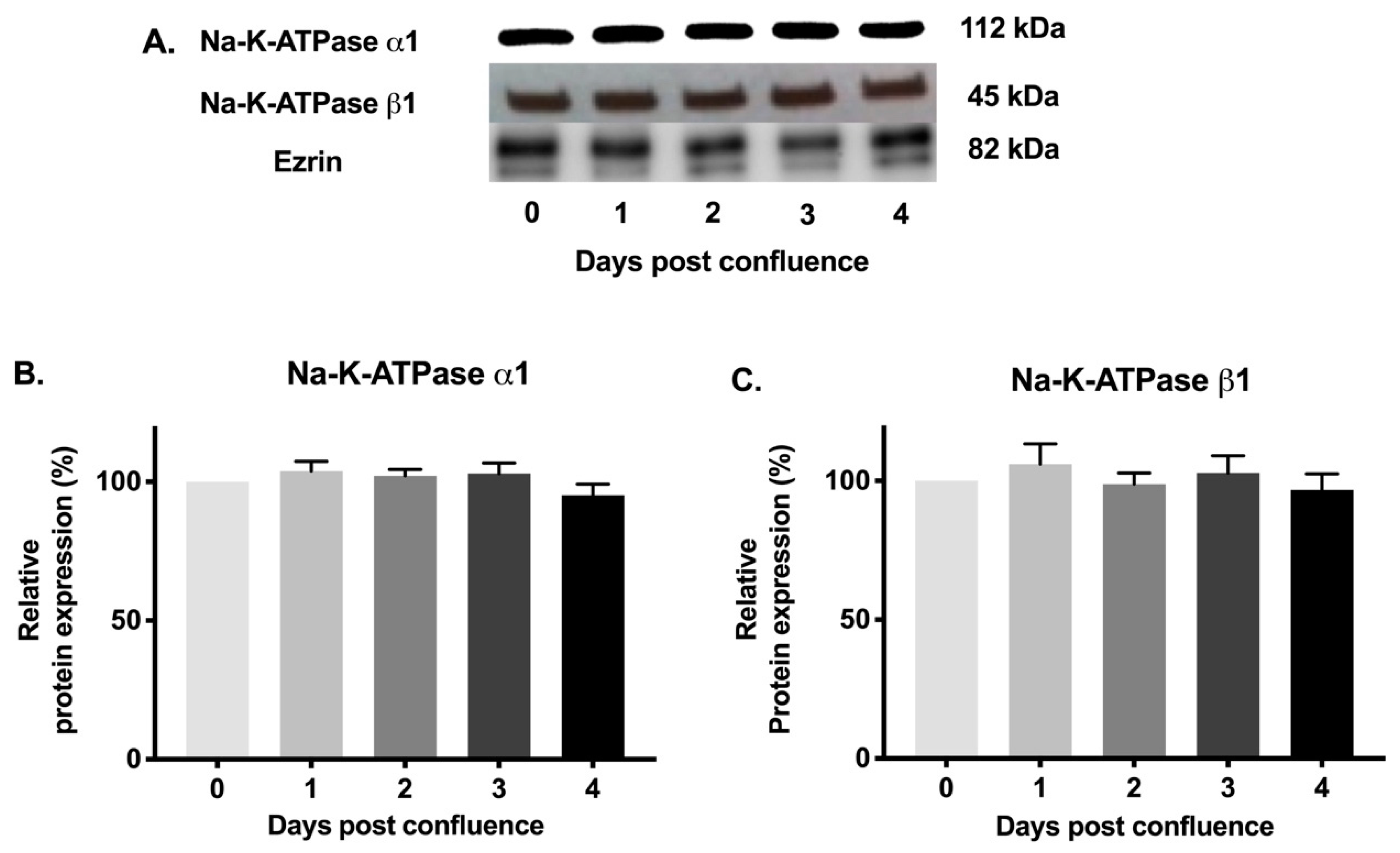
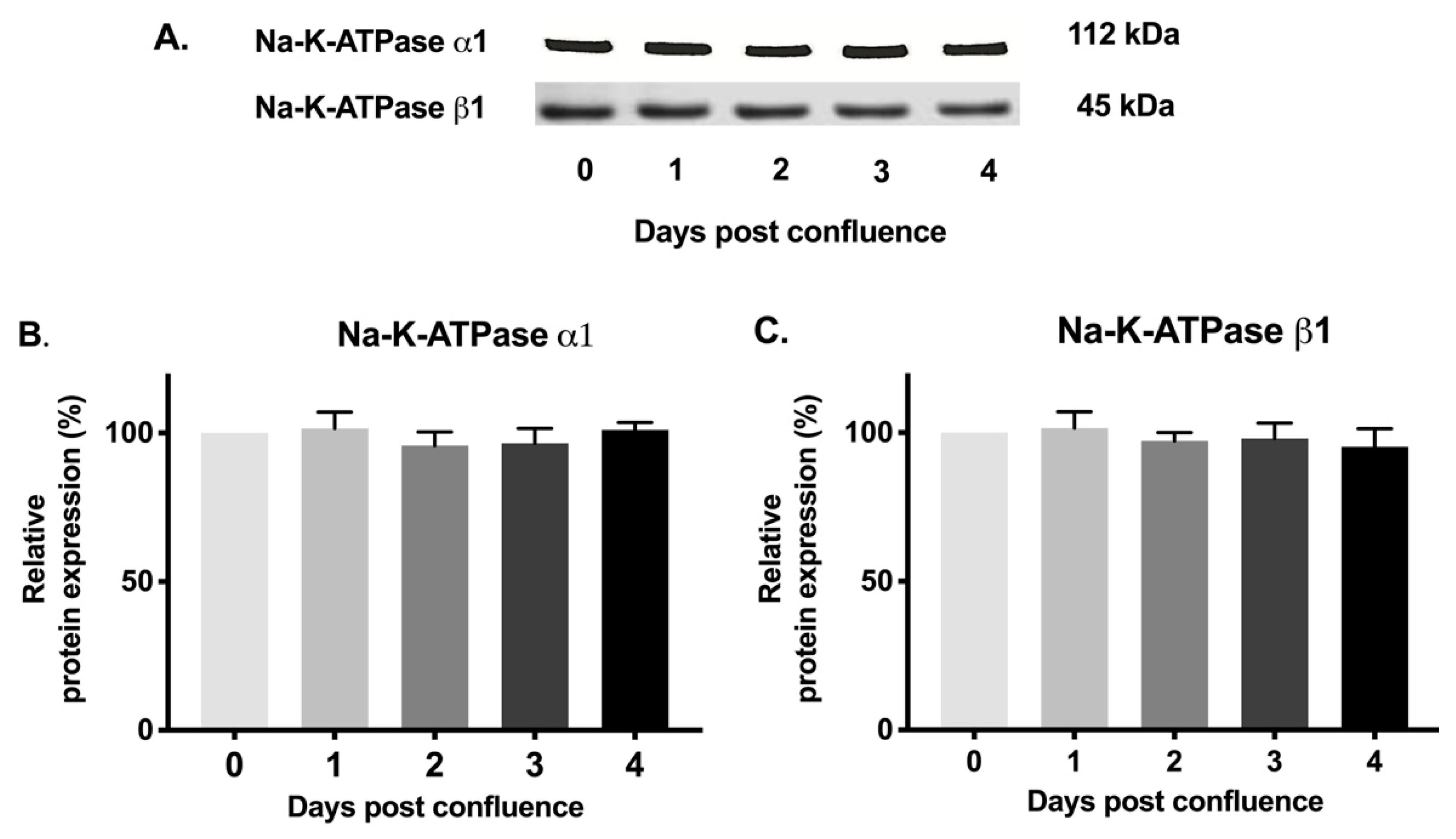
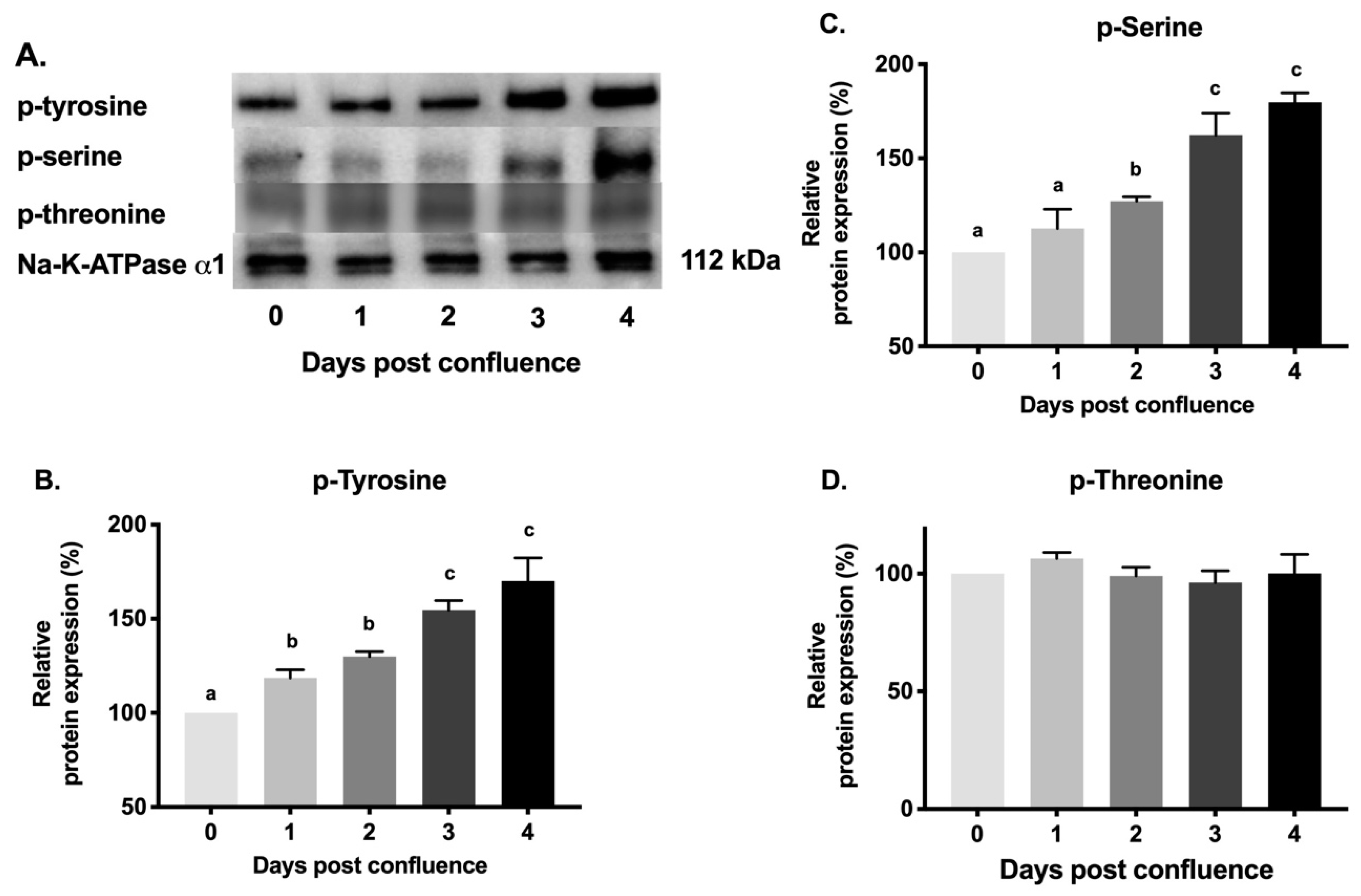
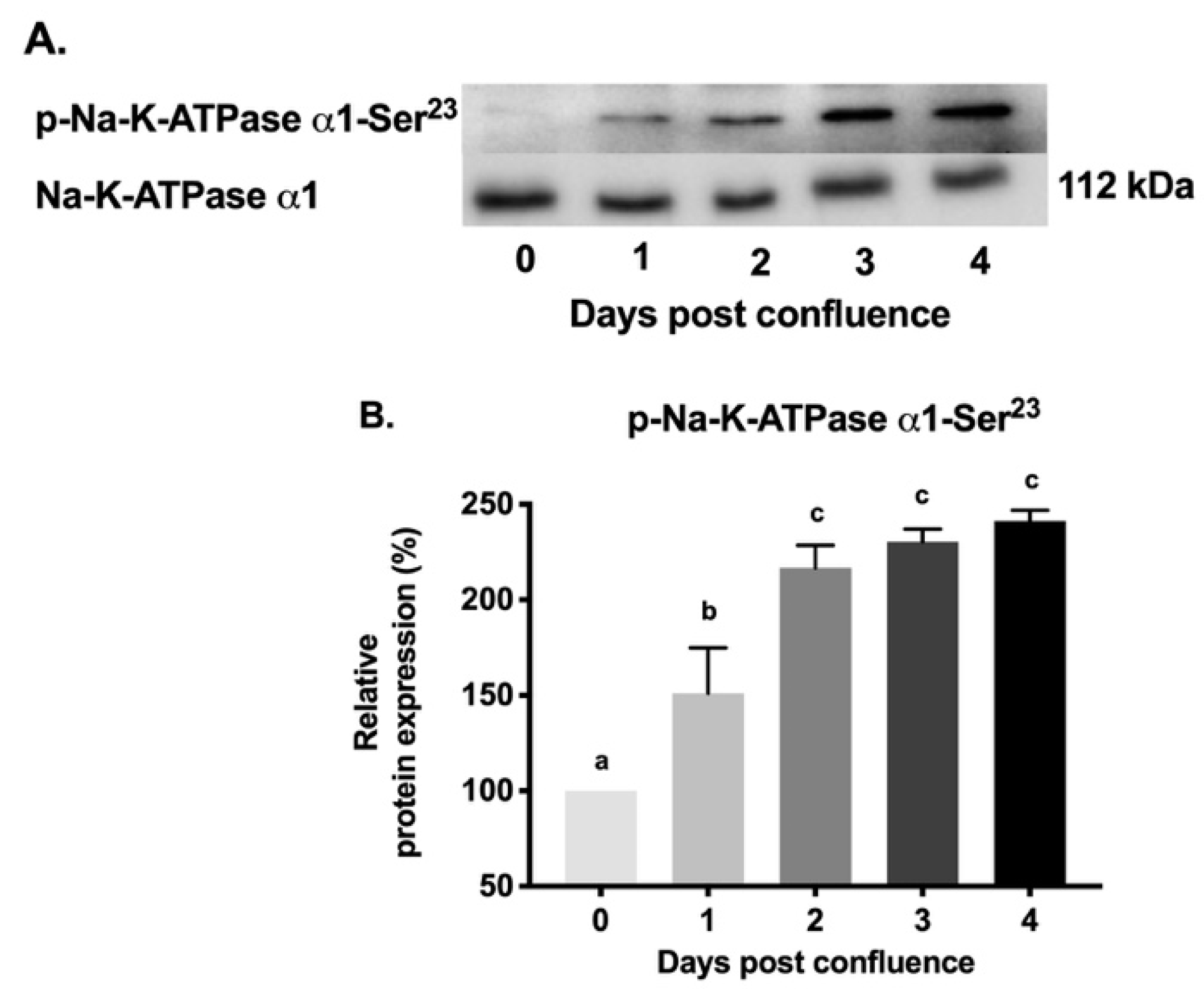
| 0 Day | 1 Day | 2 Day | 3 Day | 4 Day | |
|---|---|---|---|---|---|
| Vmax (picomole/mg protein·30 S) | 742.5 ± 62 | 714 ± 83.5 | 718 ± 58.4 | 713 ± 27.9 | 733 ± 44.8 |
| Km (mM) | 0.68 ± 0.11a | 0.61 ± 0.15a | 0.39 ± 0.08b | 0.37 ± 0.04b | 0.33 ± 0.06b |
© 2019 by the authors. Licensee MDPI, Basel, Switzerland. This article is an open access article distributed under the terms and conditions of the Creative Commons Attribution (CC BY) license (http://creativecommons.org/licenses/by/4.0/).
Share and Cite
Nepal, N.; Arthur, S.; Sundaram, U. Unique Regulation of Na-K-ATPase during Growth and Maturation of Intestinal Epithelial Cells. Cells 2019, 8, 593. https://doi.org/10.3390/cells8060593
Nepal N, Arthur S, Sundaram U. Unique Regulation of Na-K-ATPase during Growth and Maturation of Intestinal Epithelial Cells. Cells. 2019; 8(6):593. https://doi.org/10.3390/cells8060593
Chicago/Turabian StyleNepal, Niraj, Subha Arthur, and Uma Sundaram. 2019. "Unique Regulation of Na-K-ATPase during Growth and Maturation of Intestinal Epithelial Cells" Cells 8, no. 6: 593. https://doi.org/10.3390/cells8060593
APA StyleNepal, N., Arthur, S., & Sundaram, U. (2019). Unique Regulation of Na-K-ATPase during Growth and Maturation of Intestinal Epithelial Cells. Cells, 8(6), 593. https://doi.org/10.3390/cells8060593





